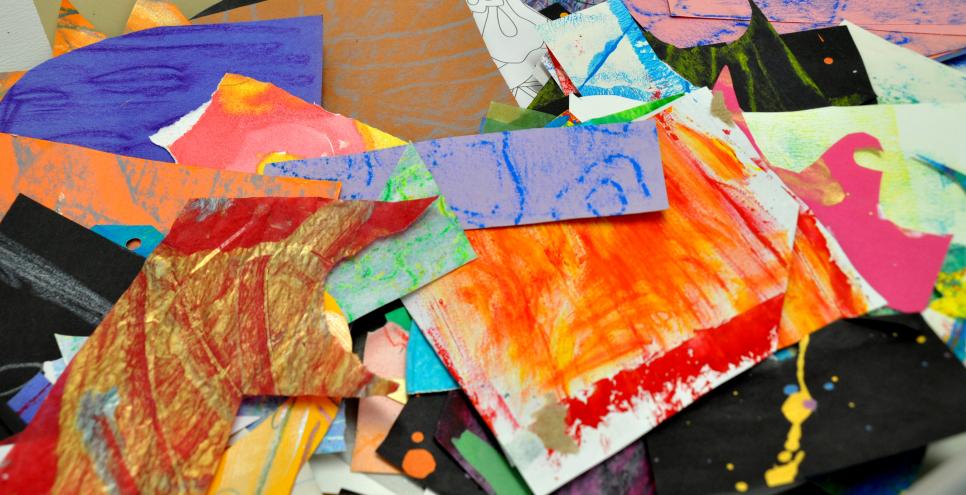Art Project to Go: Watercolor Drawing
We started to create the bags when the museum first re-opened during the pandemic due to our limited capacity in the Art Studio. Creating art projects to go has challenged us to design high-quality, budget-friendly, portable versions of our in-person Everyday Art Projects. As we are coming up on a year of to-go art projects, we thought we’d share over the course of several posts this fall our discoveries, designs, and considerations.
We’ll start the series off with our most recent to-go bag for our current project, Shape Your Story. For this project, we use watercolor drawing tools, brushes, water cups, and stencils. We encourage guests to create their own artworks using shapes as inspiration.
Drawing Tools
We decided to put three watercolor crayons into each to-go bag. We purchased the Sargent brand because they are non-toxic and create very vibrant colors. While we would have enjoyed giving out our favorite watercolor pencil, Stabilos, the Sargent watercolor crayons are a more budget-friendly option. Since they are less expensive, we could put more than one crayon in each bag. We decided on three per bag because it allows us to provide one warm, one cool, and one neutral-colored crayon. This is a nice variety, and can be supplemented with other drawing tools such as pens and pencils that folks might have at home.
Background Paper
Since we are encouraging people to watercolor using the drawing tools, we decided to put two 90lb watercolor papers in each bag. This allows for a testing paper in case the artist would like to try out supplies before making their artwork. We chose the weight paper as it has stood the test of time in our past watercolor projects.
Painting Tools
With the paper and drawing tools chosen, we then moved onto figuring out a brush alternative. It would have been cost-prohibitive to put a watercolor brush in each bag as we give out about 35 bags per week. Based upon our previous collage to-go bag, we knew that cotton swabs worked well as glue spreaders. We experimented and discovered that cotton swabs work very well with watercolors too! One cotton swab went a long way in our tests, but we decided to put two in each bag just in case one was not enough.
Cups and Stencils
In addition to the cotton swabs, we also decided to put in a 2oz compostable cup for people to fill with water to use with their watercolor crayons. While the crayons are AP certified non-toxic, we wanted to encourage people to use a different cup for artmaking than for drinking. The cup is very sturdy, and after drying out can be reused in another art project (such as creating a mobile or sculpture) before being composted. The 2oz size has been perfect for other glue projects as well.
For the stencil, we made smaller versions of the ones we are providing for this project in the studio. We punched shapes out of thin cardboard using paper punch tools. The cardboard is re-used from packaging that comes with the museum’s stamp orders, as well as off-cuts from a past Everyday Art Project that used cardboard boxes as dioramas. We put one or two stencils in each bag, depending on how many shapes were on the stencils. We wanted each bag to have at least three different types of shapes on the stencils, with somewhere between 4 and 8 shapes total for the artist to use.
Information Flyer and Bag
Having all the supplies figured out, we then created the flyer that would be attached to each bag. Each project, we provide some information on the bag’s contents suggestions on how to get started, Making Art Together categories for more ideas for artmaking, and how to sustainably dispose of materials. The flyer provides people with multiple ways of using the materials, and is a written-out version of the friendly introduction our team does for guests in the Art Studio.
For this project, we ask on the front of the flyer “How will you use shapes in your story?” and then share that several illustrators use shapes to help tell their stories. For example, shapes are hidden inside the illustrations of Circles, Triangles, Squares by Tana Hoban and Snail, Where are You? by Tomi Ungerer. We encourage people to try using stencil shapes to start their stories.
We then provide three different ways to use the watercolor crayons:
- Draw with your crayons, then dip your cotton swab into the water. Trace your lines with the cotton swab to turn them into paint!
- Add water to your paper with the cotton swab, then draw over the wet paper with your crayon.
- Dip the crayon briefly into water, then draw onto your paper.
To sustainably dispose of the materials, we suggest that folks compost their cup and cotton swabs, and recycle the watercolor paper and stencil once they are finished with their artworks.


